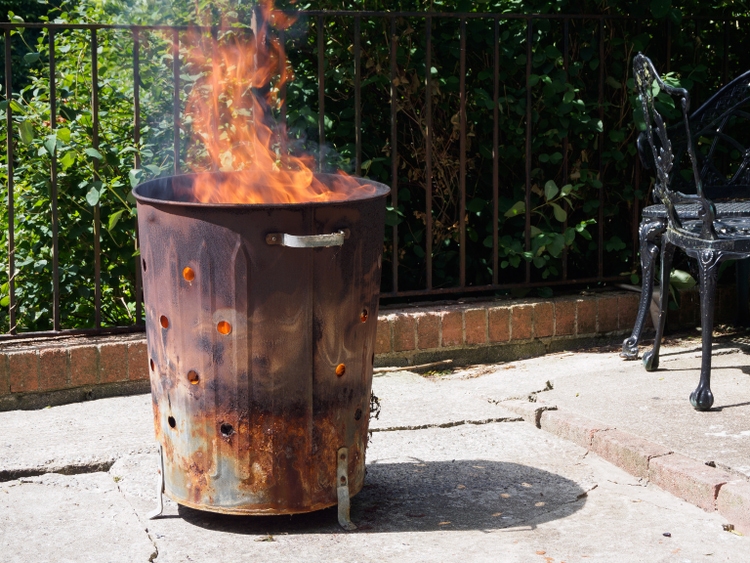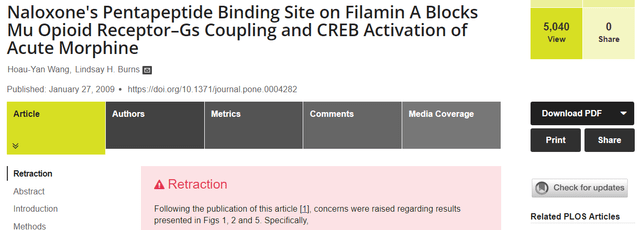
steved_np3/iStock via Getty Images
Cassava Sciences (NASDAQ:SAVA) has a big April on tap as there is potential The City University of New York (CUNY) reports the outcome of an investigation into the work of Dr. Hoau-Yan Wang, a key scientific collaborator of SAVA. Recent retractions of publications by Dr. Wang could be viewed as raising the odds that CUNY reports that there are indeed issues with the work of Dr. Wang, which would likely send SAVA downward.
Five new retractions
While there have been a few Expressions of Concern notes by journals concerning papers where Dr. Wang is an author, there had only been one retraction to date of a paper where Dr. Wang was listed as an author. March 30 however, came with news that the journal PLOS ONE had retracted five articles where Dr. Wang was an author. Dr. Lindsay Burns, Senior VP, neurosciences, at SAVA is also an author on two of the publications.

PLOS ONE
Figure 1: Screenshot of the webpage displaying one of the retracted articles.
In my opinion, only these two papers where Dr. Burns is a co-author have some sort of obvious (to me at least) link to SAVA’s current work in Alzheimer’s disease. Firstly, because Wang and Burns went on to publish subsequent research together, with other authors, including papers where simufilam (previously called PTI-125) was used in experiments. Further, these two retracted papers discuss an interaction between the protein, filamin A, and opioid antagonist, naloxone. An interaction between SAVA’s simufilam, currently in clinical trials for Alzheimer’s disease, and filamin A, is a potential mechanism behind the purported efficacy of simufilam in Alzheimer’s disease. On the one hand, those two retracted papers don’t even contain work with simufilam. On the other hand, such work can be viewed as the genesis of the idea that filamin A has within it, a five amino-acid sequence that can be targeted to therapeutic benefit, albeit in a different way to what SAVA is doing today with simufilam.
The other three retracted papers do not really relate to SAVA’s current work, not that I care to argue about anyway. The take home point is that if these five articles aren’t up to scratch, and had to be retracted, what does that say about Dr. Wang’s other papers, some of which directly study simufilam? I think it isn’t a good look for SAVA, that a key collaborator is having papers retracted, whether or not they are somehow related to SAVA’s current work. I don’t think Lindsay Burns was involved in editing any images to claim a scientific finding that was never actually achieved. As for whether or not Dr. Wang did misrepresent his findings, as the Citizen Petition and bears have suggested, CUNY could soon provide some clarity.
The CUNY investigation
Following the Citizen’s Petition submitted in August 2021 to the US Food and Drug Administration (FDA), SAVA announced that they had requested an investigation by CUNY.
… I have respectfully requested that CUNY inquire thoroughly but expeditiously into the allegations targeting Professor Wang. I have also asked CUNY that its conclusionary findings be made available to the public.
Remi Barbier, President and CEO of SAVA, September 3, 2021.
The Citizen Petition has since been denied, but due to the nature of the denial, where the FDA didn’t outright deny the allegations made in the petition, there are still questions hanging over regarding SAVA.
Based on a reading of “CUNY’s Policy Regarding the Disposition of Allegations of Research Misconduct” there has been speculation that 240 days could elapse between a request for an investigation to the time results are announced. For those wanting something more concrete, on March 30, SAVA announced a fireside chat and presentation with CEO and president, Remi Barbier. That chat is an opportunity for Barbier to answer shareholder questions, and we might get some clarity on timelines that Barbier expects for the CUNY investigation. Nonetheless, I’ve taken the 240 days number and seen where that leaves us, if CUNY did follow those potential timelines.
If we take the date that the investigation was requested as August 25, 2021, when SAVA first responded to the Citizen Petition, then 240 days would have us at April 22, 2022. If we take the date at which an investigation was requested as September 3, 2021, then 240 days has us at May 1, 2022. I find it unlikely SAVA requested an investigation on September 3 and put out those comments from the CEO on the same day, so I would think the request had to come the day before at the latest, leading us back to an April date.
CUNY should have access to plenty of information including; logs of radioactive waste leaving the lab, files that contain data behind many papers (rather than a journal receiving files relevant to only one or some papers) and invoices documenting materials purchased for use in experiments. All of that leaves me a little more confident that if there is scientific misconduct to be found, CUNY should be able to do so.
If the results of CUNY’s investigation come in April, journals waiting upon the release of the results of that investigation, that have previously issued an Expression of Concern, might provide further updates on some of Dr. Wang’s papers.
Conclusions
The upcoming fireside chat with Remi Barbier is an opportunity to discuss CUNY, the retractions and even other questions like the number of patients currently enrolled in the phase 3 studies of simufilam. I remain bearish on SAVA as I think the allegations made in the Citizen Petition and subsequent short reports are very concerning.


Be the first to comment